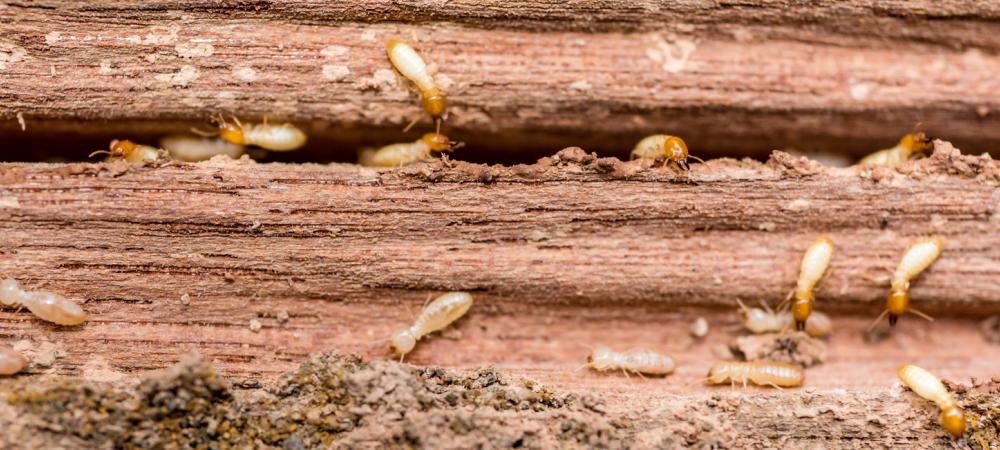8 Signs of a Termite Infestation

Termite damage is every homeowner’s worst nightmare, but in this article, we will explain the tell-tale signs of infestation. It’s very important to recognize these signs as soon as possible to prevent further damage to your home.
Termites cause over $5 billion in property damage each year in the United States. Unless you live in Alaska, your property is at risk for termite damage. Especially if you live on the gulf coast, it’s not a matter of if but when you will have termite damage. Knowing the signs of termite damage can help you limit the damage they do. In this article, we discuss the 8 signs of termites in and around your home.
1. Noise in the walls
If you listen closely, you can actually hear termites if they are in your walls. There are several common sounds: papery rustling, buzzing, clicking, and rattling. Worker termites make a rustling sound as they tunnel through wood. Swarmers also make a buzzing sound during their spring mating season. If you have a severe infestation, you may be able to hear soft clicking coming from inside your walls. The loudest termite sound is called head-banging and is performed by soldier termites when threatened. This is described as a rattling sound. This sound is used to warn their colony of danger and is made by them slamming their heads against the walls of tunnels.
2. Paint Peeling
Termites feed on cellulose material, and walls are the most susceptible to damage because they are closest to the ground. Termites hide inside the walls; deemed a silent destroyer because they are so difficult to notice. Signs of termites in your walls include small holes caused by termites eating through the wallpaper or dry paper coating. These holes are typically plugged with dirt. Sometimes small traceable line can be seen on your wall- a sure sign of their pathways. Paint may begin to peel due to the humidity that termites thrive in and need to survive. Your walls may also have a hollow sound when tapping on them. These are sure signs that there is termite activity and should get a pest technician to confirm for you.
3. Mud Tunnels
Mud tubes tend to be the most obvious sign of termites. Subterranean termites need humidity to thrive and create these tubes to block cool, dry air from coming in. These tubes are the surest way to know for sure that there are termites around or possibly in your home.
4. Damaged Wood
Termites bore into wood creatin tunnels and cavities that are difficult to view from the outside. Sometimes the only way to tell if wood is damaged is to split a section where you visibly see signs of termite activity. In the case of subterranean termites, they leave mud and debris in their tunnels.
5. Swarmers
Swarmers are the reproductive members of the colony that develop wings. During swarming season, usually spring and summer, these winged reproductives leave the colony to start a new one. They usually leave their colony in large groups.
6. Discarded Wings
When the swarmers, mentioned above, leave their nest to start another colony. They sometimes get trapped in windowsills and doorframes, especially if you have a infestation inside your home. Certain species tend to be attracted to light, so they are drawn to these doorways and windows. Swarmers shed their wings after they take flight, so finding piles of wings is a sure sign of a termite problem.
7. Frass
Frass is unfortunately just a fancy word for termite feces. Typically piles of frass look like tiny pellets or sawdust. Termites drill small holes, called kick-out holes, where they release their frass. They do this to keep their tunnels clean of debris providing more room for the termites and maintain hygiene. For subterranean termites, though, they use their waste and mud to build their shelters, making it hard to differentiate. A pest technician will need to come out to determine whether a home is infested or not.
8. Damaged or Bubbled Flooring
Termite damage can sometimes look like water damage. They can leave behind hollowed wood which can be determined by having a hollow sound when tapped. Damaged or cracked wood is also a sign of termites as well as carpenter ants. Any surface that contains cellulose material or wood is at risk of termite damage.
Knowing what to look for is the first step in the process of protecting your home from termites. Calling a certified pest control company with licensed professionals is the next step. There are options to protect your home before an infestation occurs, like Sentricon Termite Bait Stations.
Call BEEBE’S Pest & Termite Control for a free inspection today! We’ve been servicing the Gulf Coast for over 40 years!
